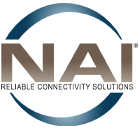
10 Nov Interconnect Options for Broadband Connections
Speed, security, accessibility… there are several different types of Broadband connection for the Internet, and they each have pros and cons. This article addresses the advantages of each type of service, and makes recommendations for the best type.
Types of Broadband Connections
Modern internet services are all types of broadband connections, as opposed to the older dial-up method of connecting to the Internet.
High-speed cable
One way of obtaining Internet services is to use a Cable TV provider to receive cable Internet. These Multiple System Operators, or MSOs, transmit digital signals along coaxial copper cable or light signals along fiber optic cable. Typically, fiber optic cables have been used as “trunk” cables to deliver signals over long hauls to metro and rural regions, where they are converted to digital signals and distributed by coaxial cables to end users at a home, business, school, etc. The more recent “FTTX” trend is to bring Fiber To The Home/Premise/Building or Cabinet/Node.
High-speed cable operators, or MSOs, are generally accepted as reliable sources for cable Internet service. The speeds they provide are among the fastest, although heavy use in a concentrated area (neighborhood) can slow down your Internet speed. High-speed cable Internet service also allows for streaming services, such as Netflix, Amazon Prime, Hulu and more, along with regular TV channels. However, if the local Internet speed is not good, then the benefits of these services are a waste. Also, cable Internet service can be more expensive, and if the service isn’t working, you’re left in the dark. One advantage of Cable TV is the large number of channels provided.
For a comparison of the top Cable TV providers offering Internet service, see Reviews.org.
DSL
DSL stands for Digital Subscriber Line, or the less used ADSL, which stands for Asymmetrical Digital Subscriber Line. This has been a very common method to access the Internet, and is provided by telecommunications carriers, such as AT&T. The same Unshielded Twisted Pair (UTP) telephone cable used for telephone service is delivering the digital Internet service. Because of the ubiquity of installed telephone lines, DSL service has been a very popular way to obtain Internet service in the recent past.
Also considered to be a highly reliable source for Internet service, downfalls have included speed and bandwidth. DSL service typically ranges from 256 kb/second to over 100 Mb/second. However, the actual performance depends on the conditions of the line, the DSL technology used, and the service level purchased. Evolving DSL technology and improvements in transmission capabilities and media have achieved up to 1Gb/second rates. Households can connect to the Internet and talk on the phone at the same time. One disadvantage with DSL is the inconsistency of Internet speed. The distance to the provider can determine the strength of your connection.
Fiber optics
Fiber optic cables are used to transmit light pulses, generated by a laser source, along glass fibers to a receiver. Usually, this receiver’s purpose is converting media. This piece of equipment converts the light signal to a digital signal and delivers it to your computer or Smart TV via FTTX. It can deliver Internet, phone, and video service. The media converter allows you to use Internet service, with the speed unaffected by the use of neighbors.
Fiber optic Internet speed is the fastest of all Internet types, but high-speed Cable TV technology advancements are allowing this medium to close the gap. Download speeds with fiber optics are generally similar to Cable TV and faster than DSL, but upload speeds are far greater than both cable or DSL. Upload speeds affect video conferencing quality. Another advantage of fiber optic Internet service is it’s level of security.
A disadvantage of fiber optic Internet service is its availability – it’s not as accessible as cable or DSL. Certain regions, areas, or neighborhoods need to install new fiber optic cables. However, the FTTX trend is making this option more accessible. Another potential disadvantage is cost. Because of the installations costs and the additional equipment required to transmit, receive and convert signals, fiber optics has been a more expensive option. However, the costs have been coming down as more installations are completed and equipment becomes less expensive.
Considering both the advantages of a fiber optic Internet, as well as its disadvantages, a fiber optic Internet is the best Internet service available from a performance perspective.
Satellite
This type of broadband connection is slower in speed and generally more costly than other options. Video chatting or online gaming can be a challenge with these lower “high” speeds. However, it may be the best choice for rural locations because one’s dish connects to a satellite in space!
Mobile hot spots
Hot spots are among the mobile types of broadband connections. This service provides a connection to the Internet using cellular networks, and requires a separate mobile hot spot or modem. The cost of different service packages are typically based on usage. That is, number of Gb used, plus connection fees. Compared to other types of broadband connections for Internet service, this one is more costly. Other disadvantages include a limit for use, after which higher fees may apply, and greater potential for hacking into your computer in public areas. The big advantage, though, is the mobility it allows for connecting to the Internet.
About NAI

